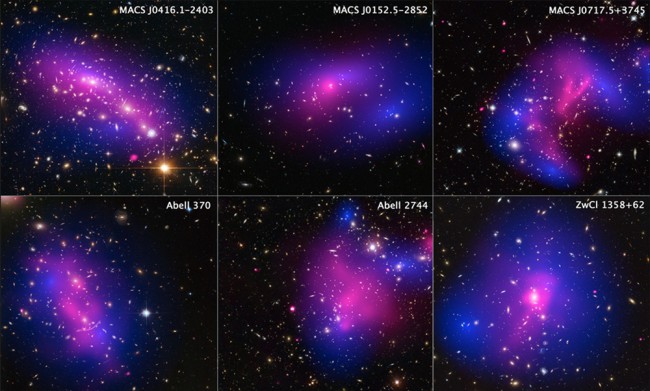This collage shows images of six different galaxy clusters taken with NASA's Hubble Space Telescope and Chandra X-ray Observatory. The clusters were observed in a study of how dark matter in clusters of galaxies behaves when the clusters collide. Seventy-two large cluster collisions were studied in total.
Using visible-light images from Hubble, the team was able to map the post-collision distribution of stars and also of the dark matter (colored in blue), which was traced through its gravitational lensing effects on background light. Chandra was used to see the X-ray emission from impacted gas (pink). NASA/ESA/STScI/CXC
Dark matter does not slow down when colliding with each other, which means that it interacts with itself even less than previously thought.
By STScl, Baltimore, Maryland | Published: Friday, March 27, 2015
Astronomers using observations from NASA’s Hubble Space Telescope and Chandra X-ray Observatory have found that dark matter does not slow down when colliding with each other. This means that it interacts with itself even less than previously thought. Researchers say this finding narrows down the options for what this mysterious substance might be.
Dark matter is a transparent form of matter that makes up most of the mass in the universe. Because dark matter does not reflect, absorb, or emit light, it can only be traced indirectly, such as by measuring how it warps space through gravitational lensing, where the light from distant sources is magnified and distorted by the gravitational effects of dark matter.
The two space observatories were used to study how dark matter in clusters of galaxies behaves when the clusters collide. Hubble was used to map the post-collision distribution of stars and dark matter, which was traced through its gravitational lensing effects on background light. Chandra was used to see the X-ray emission from the colliding gas.
“Dark matter is an enigma we have long sought to unravel,” said John Grunsfeld of NASA’s Science Mission Directorate in Washington, D.C. “With the combined capabilities of these great observatories, both in extended mission, we are ever closer to understanding this cosmic phenomenon.”

